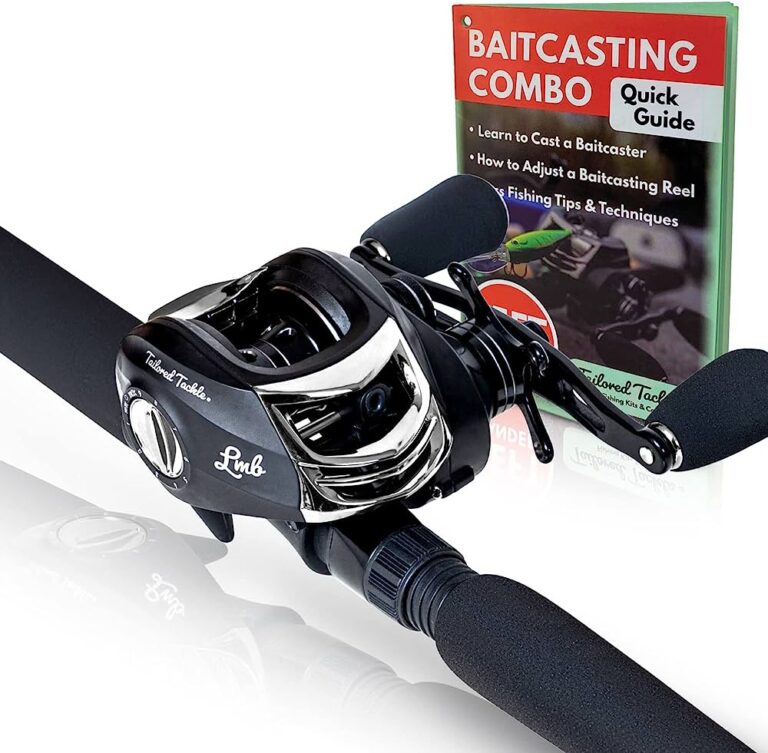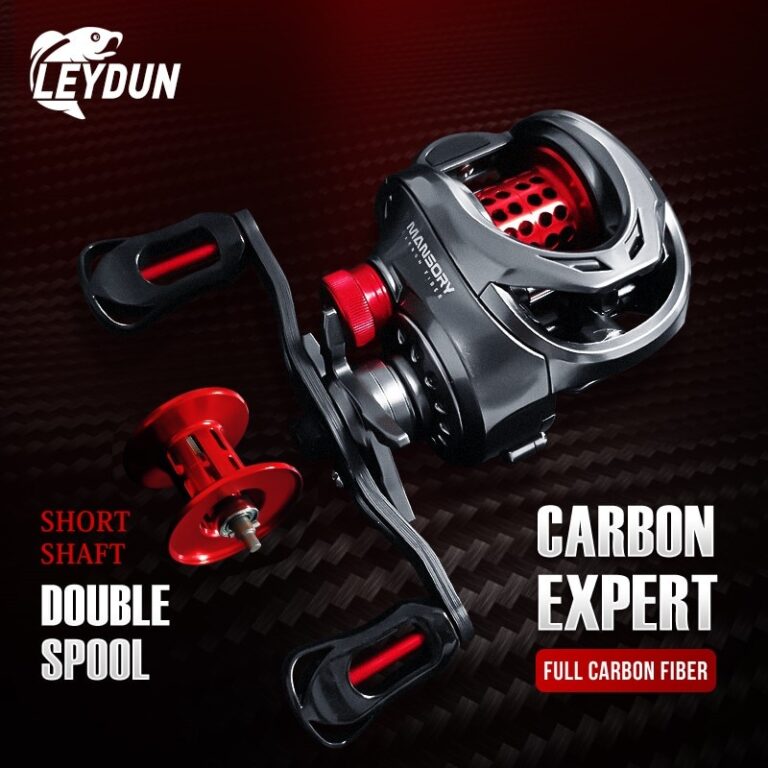Spooling a baitcasting reel requires on-point line selection. To ensure smooth casting and reeling, you should match your baitcaster with the right line type and pound-test.
Baitcasting is ideal for targeted fishing and requires specialized equipment, including the fishing line. Baitcasting lines come in different types, such as monofilament, fluorocarbon, and braided lines. Each type has its benefits and disadvantages, and choosing the right one depends on the fishing conditions and the type of bait you use.
The pound-test is also significant, affecting casting accuracy and distance. Choosing the correct line while spooling your baitcasting reel can make or break your fishing trip. In this article, we’ll go over the different types of baitcasting line and factors to consider when selecting a line for your baitcaster.

Credit: toadfish.com
Understanding The Types Of Baitcasting Lines
Baitcasting reels are popular amongst anglers, especially those who target big fish species. A baitcasting line is one of the essential components of a baitcasting setup. It’s important to choose the right type of line based on the fishing conditions and the species you’re targeting.
In this section, we’ll discuss the different types of baitcasting lines, their pros and cons, and recommended applications for each type of line.
Comparing Monofilament, Fluorocarbon, And Braided Lines
Three types of lines dominate the baitcasting market: monofilament, fluorocarbon, and braided lines. Here’s how the three compare:
- Monofilament lines are made of a single strand of nylon. They have a high stretch capacity that makes them highly resilient, ideal for fighting fish. However, monofilament lines are less sensitive than fluorocarbon and braided lines. They also have a larger diameter-to-strength ratio, limiting casting distance.
- Fluorocarbon lines are made of a single strand of fluoropolymer. They have a low stretch capacity and are highly sensitive, making them ideal for detecting bites. Additionally, their low visibility in water increases your chances of hooking up a fish. Fluorocarbon lines are stiff, which reduces their tendency to tangle, but increases their chances of backlash when casting.
- Braided lines are made of multiple strands of synthetic fiber. The strands are braided tightly together to form a thin, highly sensitive line. Braided lines have a high strength-to-diameter ratio, allowing for longer casting distances. However, their lack of stretch makes them susceptible to breaking when fighting fish, and their high visibility in water can spook fish.
Pros And Cons Of Each Type Of Line
Each type of line has its advantages and disadvantages. Here are some pros and cons of each type:
Monofilament Lines
Pros:
- High stretch capacity for shock absorption
- Easy to tie knots
- Low memory and limpness
- Affordable price
Cons:
- Less sensitive than fluoro and braided lines
- Large diameter-to-strength ratio that limits casting distance
- Susceptible to uv damage and degradation over time
Fluorocarbon Lines
Pros:
- Low stretch capacity for better sensitivity
- Low visibility in water
- Abrasion-resistant
- Highly sensitive and ideal for detecting bites
Cons:
- Expensive compared to monofilament lines
- Stiffer than monofilament lines and prone to backlash
- Difficult to tie knots
- Can break easily when fighting fish due to lack of stretch
Braided Lines
Pros:
- High strength-to-diameter ratio for longer casting distance
- Highly sensitive, ideal for detecting subtle bites
- Thin and highly visible topwater, making it easy to track
- Durable and resistant to uv damage and degradation
Cons:
- Low stretch increases chances of breaking when fighting fish
- Can be prone to wind knots
- High visibility in water can spook fish
- Expensive compared to monofilament lines
Recommended Applications For Each Type Of Line
Based on the above pros and cons, each line type is most suitable for specific fishing conditions and species. Here are the recommended applications for each type of line:
- Monofilament lines are highly versatile and are ideal for beginners or those fishing in clear water conditions with light to medium-sized fish species.
- Fluorocarbon lines are best for fishing in clear water, targeting bigger fish species and live bait fishing.
- Braided lines are ideal for fishing in heavy cover where strong lines are necessary and for targeting bigger species. They are also suitable for topwater fishing applications.
Choosing the right baitcasting line is crucial for a successful fishing trip. Monofilament, fluorocarbon, and braided lines each have their benefits and disadvantages, and the decision of which line to use should be based on the fishing conditions and targeted fish species.
Tips For Choosing The Right Baitcasting Line
Consider The Species Of Fish You Are Targeting
Choosing the right baitcasting line starts with considering the species of fish that you’ll be targeting. Different types of fish require different types of lines, and using the wrong line can result in unsuccessful fishing trips. Here are some key points to consider:
- Fish size: Larger fish require heavier lines, while smaller fish can be caught with lighter lines.
- Fish behavior: Some fish are more aggressive and require stronger, more durable lines, while others are more likely to spook easily and require more invisible, lighter lines.
- Water clarity: Clear water requires more invisible lines, while murky water allows you to use more visible lines.
Decide On The Pound Test Rating Appropriate For Your Fishing Scenario
Once you’ve considered the species of fish you’ll be targeting, it’s time to decide on the appropriate pound test rating. The pound test rating refers to the amount of weight the line can handle before it breaks. Here are some points to keep in mind:
- Depth of water: Fishing in deeper waters requires a higher pound test rating, as it takes more force to reel in fish from the depths.
- Type of bait: Heavier baits require a higher pound test rating, as they put more stress on the line.
- Fighting ability: If the fish you’re targeting is known for putting up a good fight, it’s best to go for a higher pound test rating to avoid breakage.
Understand The Fishing Conditions You Will Be Fishing In
Lastly, it’s important to take into account the fishing conditions you’ll be facing. Fishing conditions can vary greatly depending on location and weather, and choosing the right line for the conditions can make a huge difference in your fishing success.
Here are some points to consider:
- Water type: Different water types require different lines. Saltwater fishing requires lines that are more resistant to corrosion, while freshwater lines don’t need to be as durable.
- Weather conditions: Windy conditions require heavier lines, as lighter lines are more likely to get blown off course. Rainy conditions require waterproof lines to prevent damage and injury.
- Structure: Fishing near structures such as rocks or logs requires lines that are more abrasion-resistant to avoid breakage.
By taking these factors into account, you can choose the right baitcasting line for your fishing situation and increase your chances of a successful fishing trip. Remember, the key is to match the line to the species, the pound test rating, and the fishing conditions.
Conclusion
After reading this article, you should have a good understanding of the different types of baitcasting lines and which ones would be best suited for your specific style of fishing. It is important to consider the conditions you will be fishing in, as well as the type of fish you are targeting.
Fluorocarbon line is a great choice for clear water situations and when fish are finicky, while braided line is unbeatable for its strength and sensitivity. Monofilament line is a budget-friendly option and is versatile in different fishing scenarios. It’s essential to spool your reel properly, ensuring that you get the most out of your baitcasting line.
By selecting the correct line for your setup, you’ll improve your chances of success on the water. Don’t forget to regularly check your line condition and replace it when necessary. Happy fishing!




